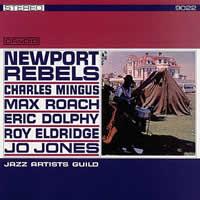Mingus! Roach! Dolphy! Eldridge! Jo Jones Fight Waterfront Commercialization
Back in 1960, when the cultural esthetic was more pure, a group of jazz musicians broke away from the Newport Jazz Festival-which was actually held in Newport R.I.-to protest what Nat Hentoff refers to in the liner notes as the “…annual Ben-Hur-with-a-horn production at Freebody park.” Mingus and Roach led the charge, holding an alternative festival at Cliff Walk Manor. That year, while street riots closed the official festival early, the alternative event, booked, advertised, promoted and produced by the musicians continued without problems. Mingus, according to the notes, even demanded and collected money from freeloaders.
After the festival, the rebellious musicians formed the Jazz Artists Guild, intending to produce both live events and studio recordings. The all too predictable result was in-fighting, with not much coming of it, according to Hentoff, with the exception of this recording.
On it, Hentoff chose to correct what he saw as one of the Cliff Walk Manor festival's deficiencies, which was that the younger and older players didn't mix. Back then there was considerable tension between the big banders, the boppers and the nascent avant-garde players. Today all of these guys, most of whom are gone, are all considered veterans, but back then, of course, that was not so.
Hentoff felt common ground could be reached, so here, we have Roy Eldridge and Charles Mingus playing together for the first time, and Eric Dolphy playing with Tommy Flanagan and Jo Jones. Other participants include Max Roach, Booker Little, and Kenny Dorham. Candid recording artist Abbey Lincoln joins on one tune and Hentoff again mentions that she's abandoned her “..sultry supper club puppet…” days (see September review of Lincoln's Candid reissue).
The set opens with Mingus's “Mysterious Blues” featuring Mingus and Jo Jones on rhythm, with Flanagan on piano. That alone would make for a tasty treat, but added are Eldridge, Dolphy, and Jimmy Knepper (trombone), all of whom are given room to stretch a bit in the eight minute plus tune. Jo Jones and Mingus give the jam a smooth, easy pace, with Jones's light touch putting Mingus in a relatively mellow mood. Dolphy (right channel) and Knepper (left) drive the riff home, with Eldridge adding the icing.
Booker Little's hot “Cliff Walk” features both Max Roach and Jo Jones on drums. The notes properly point out who is where in the stereo mix. Walter Benton on tenor, and Julian Priester on trombone help Little drive the nervous melody over the charging drums. This is the set's high point for me.
Side two features the standards “Wrap Your Troubles In Dreams” and with Lincoln on vocals, “Tain't Nobody's Business if I Do,” featuring Dolphy, Dorham, Jo Jones, “Peck” Morrison (bass) and Benny Bailey on trombone.
The album closes with “Me and You,” an almost ten minute slinky jam from the Mingus-Eldridge session, featuring the same musicians as the album opener. Eldridge delivers his most intense recorded performance (at least that I've heard), playing strip-tease style part of the time, goaded on by Mingus's “bump and grind” bass lines. Great fun.
The sound is what you'd expect from a Nola Penthouse Sound Studios recording: very pure open and lively, with the individual instruments jumping from the soundstage. While each instrument is well recorded, the overall presentation can be faulted for hard left/right panning of most. For instance, on the last track you have the drums hard left, piano hard right, with Eldridge's trumpet suspended in between. Hardly a natural spread, but you'll forgive it for the clarity and transparency of the instruments-especially the piano, which was often boxy-sounding on other recordings from this era. Mingus's bass is also captured ideally, and Eldridge's trumpet is right there in your room. No kidding!
Another great choice by Pure Pleasure from the Candid catalog that's easy to recommend.




